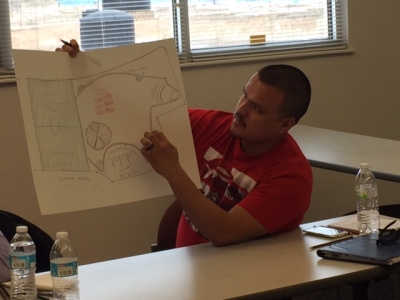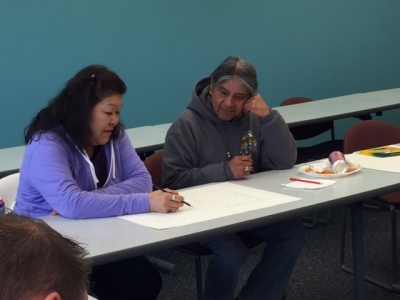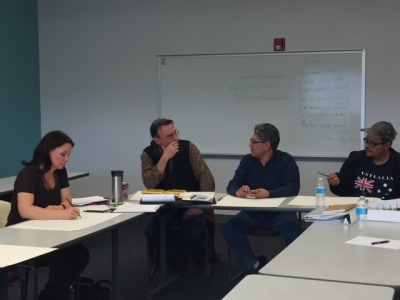Announcement & Community Forums:
The most important memories from the period after we were announced as a CDI grantee are ones of newly inspired optimism and a fresh excitement for living in the Zuni Pueblo. Zuni is a place where kids and families travel long distances in order to play in a park or see a performing arts event. While Zuni is home to one of the most densely populated communities of artists in the country, Zunis generally need to leave the Pueblo in order to see this art displayed in public spaces. Being a grantee has the potential to fundamentally change all of this, and it has awakened a sense of community engagement. As a remote Native reservation, large grants are sometimes announced to the community for government projects that are not necessarily seen having a tangible impact on daily life. In contrast, the more the community has learned about ArtPlace and the mission of the CDI program the more they have spontaneously begun to offer assistance, ideas, and partnership.
 The day of the announcement, I was coaching a competitive youth soccer team which, for years, has hung together despite the fact that we must practice on a dirt field pocked with prairie dog holes and brush. That evening, we began practice as usual, by covering up the holes in the field, when I announced the big news. At that moment 25 Zuni kids began cheering and talking about how much fun it would be to have a real field. A few dreamed that maybe there could be a high school team someday. Zuni artists had a similar reaction as we held our first planning meeting. Suddenly ideas that have never been developed in Zuni were flowing freely. Several accomplished carvers began brainstorming on how they could create large sculptures for the project, an art form not tried before in Zuni. Others began to talk about who could best contribute to a series of murals, and another artist drew a sketch of a walking path in a traditional Zuni design. The Zuni Tribal Council spoke to us about their hope that this project could invigorate a new sense of community engagement and result in a space that brings people together and reminds them why it is so special to be Zuni.
The day of the announcement, I was coaching a competitive youth soccer team which, for years, has hung together despite the fact that we must practice on a dirt field pocked with prairie dog holes and brush. That evening, we began practice as usual, by covering up the holes in the field, when I announced the big news. At that moment 25 Zuni kids began cheering and talking about how much fun it would be to have a real field. A few dreamed that maybe there could be a high school team someday. Zuni artists had a similar reaction as we held our first planning meeting. Suddenly ideas that have never been developed in Zuni were flowing freely. Several accomplished carvers began brainstorming on how they could create large sculptures for the project, an art form not tried before in Zuni. Others began to talk about who could best contribute to a series of murals, and another artist drew a sketch of a walking path in a traditional Zuni design. The Zuni Tribal Council spoke to us about their hope that this project could invigorate a new sense of community engagement and result in a space that brings people together and reminds them why it is so special to be Zuni.
These sentiments were also evident during our community forum. Community forums are often poorly attended in Zuni, and so we were not sure what to expect. We set up a large tent with music and food and hoped for a few dozen interested people to attend. The evening turned into a positive community event with close to 300 attending, including about 20 artists who displayed their work. Participants shared their ideas for a future Creative Place by placing dot stickers on posters that asked for their input. The party continued well past dark and served as a great example of the kind of event that will hopefully be much more common in Zuni’s future.
Cultural Asset Mapping:
The cultural asset mapping process has been a fascinating learning opportunity for ZYEP. In addition to obvious technical questions, it brought out several important questions about Zuni itself.
First, how should we define a cultural asset in Zuni? Unlike many metropolitan areas, the cultural assets on the reservation are not institutions or entities that can be identified on-line or through a typical search. Zuni is a small, tight- knit community with few institutions formally dedicated to art and culture. The one or two that do loosely meet these criteria are well known and easily identified. The richness of Zuni’s cultural assets, while palpable, is beneath the surface. Two such assets are the Zuni religious system and the rich network of individual Zuni artists. Identifying discrete cultural assets in this informal, and often secretive, context has been challenging.
A second question ZYEP is working to address is: Once we have identified the major cultural assets (e.g. self-employed Zuni artists, Zuni religious leaders and systems), how do we engage them in ways that are culturally appropriate? There is not a recognized organization that represents Zuni artists. Most work independently and sell their art the same way it was done one hundred and fifty years ago (i.e. through trading posts that pay the artist a fraction of the real value). Most artists work from home and are also caring for small children, which makes it hard for them to attend meetings. The religious leadership is even more challenging to engage in this process. The Zuni religion is the foundation of all Zuni culture and it dictates many aspects of daily life. To ignore this influence would be to disregard the most important cultural asset Zuni has. On the other hand, the Zuni religion is sacred and has many secret elements, which requires us to develop culturally sensitive and indirect approaches.
With these challenges in mind, our most important goals are to 1) capture the voices of the vast number of Zuni artists who are often working alone and not organized as a collective voice, 2) include the voices of youth, 3) reflect the foundational influence of the Zuni religion in a way that is completely respectful of Zuni traditions and privacy, 4) share the results of the cultural asset mapping work with the community, and 5) ensure that these results inspire the design of our CDI projects. To accomplish this, we’re planning to partner with another local non-profit with deep ties to several important religious and arts groups and use a combination of photo voice, focus groups, community surveys, and documenting artist’s accomplishments.
Lessons & Insights:

We continue to learn throughout this journey. Some of our most important ideas so far include:
1) It is important to identify the potential stakeholders and develop a tailored approach for each group. For us, the stakeholders include Zuni youth and families; the religious leadership; Zuni artists; the Zuni Tribal Council, and the neighborhood surrounding the public park we’re planning to build. Identifying these as unique stakeholders has helped us to have more efficient dialogue and ensure that no one is neglected.
2) We want to ensure that the process of creative placemaking itself has a positive effect on the community, not just the finished product. We want the process to promote civic engagement and foster a belief that people have a voice in the future of the Pueblo. Secondly, we have identified many areas where we will need to consult with professionals from outside the Pueblo (e.g. architects, builders, program evaluators). Whenever this is needed, we want to engage local people as interns or apprentices in the process, thus increasing the capacity within the pueblo.
3) An important challenge will be finding the right balance between planning and action (i.e. how do we know its time to finalize design plans?) as well as between the vision of the organization and the ideas of others (usually outside consulting groups).
4) If we want to objectively evaluate the success of the project, there are many important pieces that need to be in place now. We hope to demonstrate that by incorporating art and culture into this community development project, the final product is more effective at promoting community health. In order to do this, we need to gather certain baseline data, develop evaluation methods, and probably obtain IRB approval before any construction begins.
There are many things we are looking forward to over the coming years. These include:
- Learning how to move from ideas to action and transform the results of our community engagement process into a wonderful public space
- Ensuring that the process of community engagement and partnership continues beyond the planning process and becomes a standard part of our organization’s activity
- Learning how to perform a robust, objective program evaluation
- Identifying and commissioning artists
- Dealing with the inevitable and unforeseen political or community relations issues that will arise over time.






